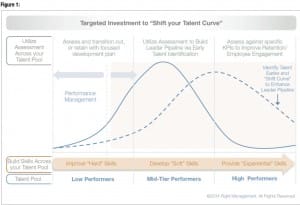 Organizations need to rethink how they manage talent and develop the next generation of leaders.
Organizations need to rethink how they manage talent and develop the next generation of leaders.
By Ruediger Schaefer
Today’s optimism for growth is limited by a lack of organizational agility. C-suite leaders who look to retire after sailing through rough recessionary waters are tethered by weak leadership pipelines that threaten not only their next move, but also their organization’s growth potential. Boardrooms around the world are feeling the repercussions of the financial cutbacks, belt-tightening and right-sizing that knocked talent management off the executive agenda. Insufficient investment in talent development has hit organizations hard and at all levels. Increasingly, employers struggle with grooming and growing the talent needed to fill leadership positions with individuals who have the skills needed to turn strategy into action.
To learn more about global talent management trends, Right Management asked HR leaders from 13 countries about their top talent management challenges and priories. Our study, Talent Management: Accelerating Business Performance, found that although HR leaders have a positive outlook about the year ahead, they still lack adequate leadership pipelines and face widespread skill shortages. In fact, talent management has become so critical to business growth and economic progress that it is forcing organizations to re-examine how they attract, develop, retain, and engage employees and future leaders.
What’s clear is that talent management is no longer simply the purview of just the HR department. As boardrooms and C-suites focus on driving competitive advantage to improve financial performance, talent is increasingly moving to the top of the agenda. Simply put, without a workforce strategy in place, companies lacking the right people to lead face a talent gap with potentially severe business consequences.
Leadership Development is First Priority
The number one priority for senior HR leaders around the world is leadership development. The leaders of tomorrow -the high potentials within each organization -need to master a range of skills to lead successful organizations. They need to possess opposing skill sets: be strategic yet tactical, conceptual yet action- orientated, able to anticipate yet react, as well as have the ability to push boundaries, master new skills, and coach their teams.
Encouragingly, our study shows 46 percent of organizations globally are planning to invest in leadership development this year. This focus on investing in leadership development is highest (55 percent) in the Americas and lowest (37 percent) in Europe. The good news is that only 7 percent of companies plan to make investments in outplacement and workforce transitions, reinforcing that most employers will be focused on talent management rather than further cutbacks and restructurings.
Interestingly, HR leaders in both Brazil and France report assessment of skills throughout the organization as the top talent management initiative for 2014, jwhile those in Australia and the Netherlands cite team building, and China/Hong Kong respondents report executive coaching as top priorities.
Poor Leadership Pipeline
Startlingly, only 13 percent of HR leaders have confidence in the strength of their leadership pipelines, with Canada, Singapore, Germany, the U.S. and Australia reporting the least trust in their current leadership planning.
Most organizations (73 percent) rely on a mix of internal talent development and external hiring to fill leadership positions, but the results show that this doesn’t instill confidence in the pipeline.
 The merits of developing talent within an organization are widely recognized, while outside hiring is viewed as a temporary fix. HR needs to shift the talent curve by identifying and developing high potential talent within organizations to fill their leadership pipeline. Potential leaders can be identified early on through ongoing assessment of employee talent. Coaching and developing employees at the “center of the curve” leads to better bench strength at the mid and senior levels and improves employee loyalty and engagement (see Figure 1).
The merits of developing talent within an organization are widely recognized, while outside hiring is viewed as a temporary fix. HR needs to shift the talent curve by identifying and developing high potential talent within organizations to fill their leadership pipeline. Potential leaders can be identified early on through ongoing assessment of employee talent. Coaching and developing employees at the “center of the curve” leads to better bench strength at the mid and senior levels and improves employee loyalty and engagement (see Figure 1).
Aligning the C-Suite
While HR leaders are prioritizing and strengthening their leadership pipeline, it is critical that they are aligned with their C-suite, pushing in the same direction for growth. An overwhelming 88 percent of senior management either almost always (40 percent) or sometimes (48 percent) sees the connection between investing in talent management and its business impact. Talent managers and HR leaders are doing a good job elevating the importance of HR and how talent issues impact competitive advantage. Moving forward, HR professionals must continue to partner with senior executives to connect the dots between leadership development and financial growth.
Although buy-in to improve talent management is making head way, our study shows that one in five senior management teams are asking for more rigorous measurement to show business impact. With only 30 percent of respondents citing their senior management is confident that talent management efforts are paying off, it is more important than ever for HR leaders to demonstrate that development programs are money well spent through metrics that show return on investment.
HR Leaders are Optimistic about the Future
Despite many talent management challenges, 46 percent of HR leaders report that this year will be a year of growth for their organization, showing promise for increased investment in talent management. Confidence levels vary from region to region with Asia Pacific showing the greatest confidence in growth at 61 percent, followed by the Americas where one in two HR leaders are confident 2014 will be a year of progression. Europe is the least confident in growth, but encouragingly only 7 percent of HR leaders in Europe believe that there will be no growth and reduced spending on talent management initiatives.
Overall, with fewer restructurings on the horizon, HR leaders can focus more on looking inward to engage and retain their best and brightest in order to build that next bench of top leaders.
Increased Focus on Engagement
Nearly half (48 percent) of HR leaders globally are planning to broaden their employee engagement programs, with 59 percent of those in Asia Pacific stating they intend to invest in programs that help their employees feel valued. Persistent talent shortages are starting to be a wake-up call for employers who want to keep skilled and valued employees on staff.
Best-in-class organizations use employee engagement as a mindset, rather than a temporary program that starts and stops when morale is negative. They not only measure engagement but proactively approach employees to ensure the most effective solutions. Right Management recommends three steps to optimizing employee engagement: define, listen, and engage.
Organizations must define the key workforce priorities critical to the business so that the right metrics can be implemented and companies can be more strategic about their workforce needs. Business leaders must also listen by creating open channels for employees to communicate their pressing needs and challenges. Finally, business leaders must be accountable for taking action on employee feedback with direct results. Only then will employers begin to see an engaged workforce that wants to belong and deliver for the organization.
Future Success
Budget reductions have had an impact on competitive advantage, largely because talent management was placed on the back burner. When investment in talent management and development is a low priority, the ripple effect can hurt the bottom-line. Weak leadership pipelines limit future growth. Today, succession planning is essential for business advantage. Executives are now less focused on cost-cutting and more focused on unleashing growth potential to drive financial performance. As the CEO agenda is now refocused on talent management, HR leadership can play an enormous role in solving not only succession planning challenges, but also financial performance that can thrive when a workforce strategy is aligned with business goals.
Ruediger Schaefer is group executive vice president for Right Management. View Right Management’s study Talent Management: Accelerating Business Performance at http://insight.right.com/ talentsurvey2014.














